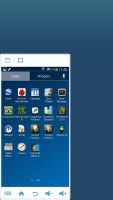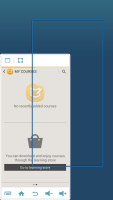Samsung Galaxy Note 3 review: Jugger-note
Jugger-note
TouchWiz on the big canvas
The Samsung Galaxy Note 3 comes with Android 4.3 Jelly Bean - the latest release of the Google platform available at the moment - and a laundry list of new TouchWiz features. The Galaxy Note 3 combines the best of both worlds and while it seems familiar, there's plenty new below the surface - so much in fact that you'd need a couple of days just to get to know all the features.
Here's a user interface video to start you off, which also shows the new air and motion gestures in action.
We start with the lockscreen, which features the widgets introduced with Android 4.2.2, that we saw on the Galaxy S4. The default lockscreen shows the time along with a personal message overlaid on beautiful photos pulled from TripAdvisor (with text at the bottom about where the photo was taken).
You can choose what effect to add to the unlocking. The options include Oil paint and watercolor, which blur the color on screen as if you were dragging a wet paint brush through the screen. You can also opt for the well-known ripple and light effects.
The lockscreen has multiple panes, each containing one widget. The page to the right of the default one is special and can either be a list of favorite apps (the default TouchWiz setting) or a shortcut for the camera (as in pure Android).


Favorite apps or camera shortcut
The pages to the left contain different widgets - email, Google Now, Messaging, music player, Yahoo! Finance and News and you can download apps from the Play Store that add new widgets.
There are no app shortcuts at the bottom of the screen by default - the Favorite Apps widget to the right has taken over that role, but you can enable them and have up to five easily accessible shortcuts.
You can change the greeting message on the lockscreen by hitting the edit button. You can type something else, choose a different font and color. You can also disable the personal message altogether and remove the time and date info.
Another nice trick is the Quick glance option we first saw on the Galaxy Note II. It uses the proximity sensor to detect you reaching for the device and it lights up the screen and shows the time, missed call and message counters, battery charge and music track info.
The notification area is business as usual and hasn't seen any changes. At the top there are five (or eight in landscape mode) toggles that can quickly enable and disable features. There are more than five toggles, of course, you can swipe horizontally to get to the others. Or you can tap the expand button, which reveals a grid of all the shortcuts, 22 in total. You can rearrange this grid (the top row toggles are always visible). A two finger swipe directly opens the grid of toggles.
Below the toggles is the display brightness slider complete with an Auto toggle. You can remove this slider to get more room for notifications.
The notifications themselves have not changed - they can be expanded to reveal more info and collapsed to save space or dismissed with a sideways swipe. Sometimes they also have helpful buttons on them like "Call back" and "Send SMS" on a missed call notification.
The homescreen looks mostly the same if you're coming from a Galaxy S4. Samsung has provided many of its own custom widgets like Samsung Hub, S Travel, etc. There's wrap around feature, which lets you scroll homescreens infinitely by always going from the last to the first one.
You can pinch zoom to get into the overview mode with all homescreen panes visible simultaneously. There can be up to 7 and you can easily add, remove and rearrange panes from here. One pane is marked as "home", that's the one you go to when you press the Home button - you can choose a different homescreen as the default quite easily.
The app drawer hasn't changed too much since the early days of Nature UX. The app shortcuts are presented as a customizable grid, alphabetized grid or list and you can hide shortcuts (good for bloatware you can't uninstall), view only downloaded apps, uninstall apps and add folders. You can also disable apps straight from the App drawer, which is a good feature because they won't take any RAM or appear unwanted in the Task manager.
You can also maximize space in the app drawer by stacking apps into folders. You can either drag icons on top of each other in edit mode or you can check multiple app via the create folder option.
As before, widgets are in a separate tab in the drawer.
Pinch to zoom in the app drawer works the same as on a homescreen - it gives you a glance overview of all panes as thumbnails. You can choose to have your app drawer ordering to custom, alphabetical grid or alphabetical list. There's a dedicated downloaded pane too, where all your downloaded apps go.


App and widget drawer at a glance
When you drag out shortcuts and widgets to the homescreen you get a list of small thumbnails of all the homescreen panes with the silhouettes of the widgets there so you can judge how much space is available on each pane.
The App switcher interface is unchanged - there's a list of thumbnails of all the recent apps, apps can be swiped to dismiss and there are three buttons at the bottom, Task manager, Google Now and Kill all apps.
The Galaxy Note 3 comes with Multi-window which now allows launching two instances of the same app - i.e. you can have two Chrome windows next to each other. There is also dedicated shortcut that lets you switch the places of the two opened apps.
Copying stuff from one of the opened apps to the other is now available and is done in just three taps. It's a definite improvement and something the multi-window feature needed badly.
We noticed there is pretty decent app support for the multi-window service at launch with even more supported apps on the way. It's a feature that will be used really often and we are happy to see Samsung extending its support.
You can move the small arrow that brings up the drawer with the Multi-window apps to make it easier to reach with your thumb. You can also move the whole drawer to the other side of the screen.
The settings menu has been redone in the latest TouchWiz version. Instead of a scrollable grid of icons and sections Samsung has went with a tabbed interface. On top you get four tabs - Connection, My device, Accounts and More and you can find the relative features in their corresponding place - display, for instance, is in the My device tab.
It makes navigating the settings menu much faster and more intuitive.
A particularly cool feature that is exclusive to the Galaxy Note 3 is the one-hand operation. Unlike previous versions of the feature, though, it is not limited to the keypad and the calculator. This time you can minimize the whole interface with a simple double swipe and you are effectively making the Galaxy Note 3 use only a corner of its screen for its UI. The volume buttons are also brought to the tip of your fingers so you can operate the handset as if it was a 4" (or slightly more - custom resizing is available) rather than 5.7" screen.
That's a really useful feature and will be appreciated by all those that love the huge screen and its excellent multimedia performance, but need to be able to operate their smartphones with one hand frequently.
We like what Samsung has done with the latest iteration of TouchWiz. Despite pilling feature upon feature, the end result does not feel cluttered and intuitive and well organized. Placing widgets, rearranging menu and homescreen panes, getting to your important settings, etc. is now faster than ever.
It's also very responsive, thanks to the superb hardware inside. Everything happens instantaneously and there is no lag to be spotted whatsoever.
Reader comments
- Loli
- 09 Nov 2023
- 864
If you're still using stock firmware that's why. 4.X and even 5.0 (official maximum) is now passing the warning line of many apps. If you aren't familiar to (and don't want to bother with) XDA forum, just go to LineageOS website...
- kelvin
- 28 Oct 2023
- fuZ
Android virsion not support in my SamsungN9005 What's going on but am still needed to use this phone
- Anonymous
- 22 Sep 2023
- L5x
Using custom ROM




































